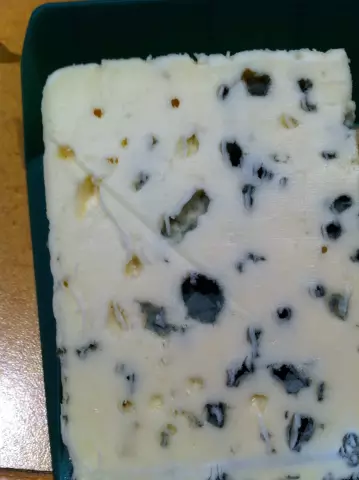- Author Rachel Wainwright [email protected].
- Public 2023-12-15 07:39.
- Last modified 2025-11-02 20:14.
Roquefort

Refined products are highly appreciated by true gourmets. A special place among all kinds of delicacies is occupied by cheeses with blue mold. They are produced in different countries - Italy, France, Denmark, Germany. The world-wide fame, despite a fairly large selection of such products, is Roquefort cheese, which is made in France in the town of the same name in the province of Rouergue. The bluish mildew and distinctive taste give this truly French brand a certain touch of extravagance. It is she who makes the roquefort cheese with mold attractive for its real lovers.
Roquefort cheese, history
Cheese, as a dairy product, has been known since ancient times. What explains the exclusiveness of Roquefort? Firstly, unlike other types of cheese, it is made only from sheep's milk, which already gives it a special unique taste. Secondly, the curious history associated with its appearance contributes to the development and maintenance of consumer interest in Roquefort cheese. Like many new world-renowned products, cheese owes its origins to "master chance". There are various legends about this in France.
The most popular is the romantic story of a young shepherd. He saw a strikingly beautiful girl and went after her, forgetting even that he was going to eat. The modest breakfast was left in the limestone grotto. The shepherd returned to his native place only after a few weeks. To the boy's surprise, his forgotten "sandwich" of sheep cheese and rye bread not only did not deteriorate, but also acquired an unusual piquant taste. Thus, a new type of cheese appeared - Roquefort cheese with mold. It got its name in honor of the nearby town of Roquefort. Since then, local residents have been engaged in the manufacture of a special type of dairy product, having received a monopoly on this from the French king.
Features of making cheese
What happened to the "sandwich" during the shepherd's absence? Naturally, the rye bread had time to get moldy. It also promoted the growth of molds on cheese, which, unlike bread, remained quite edible. The new taste turned out to be so exquisite that soon ordinary sheep's cheese was specially aged under certain conditions until mold appeared. To obtain the required quality, the product must mature for several weeks. The production process for Roquefort cheese has hardly changed over the past centuries.
It is possible to maintain a special microflora in special storage facilities - limestone caves. Spores from a fungus such as Roqueforty penicillium are added to mold to form during the standard Roquefort cheese making process. Under favorable conditions, this fungus spontaneously appears in the form of mold on rye bread. Some manufacturers even make cheese ripening molds from such flour. As a result of multiplication, the spores spread rapidly, forming characteristic cavities in the finished product. Against the background of a light cheese mass, the mold stands out for its bluish color. In order for cavities to form evenly in the cheese, it is pierced with special needles.
As a result of long ripening (at least 3 months), moldy Roquefort cheese acquires a subtle taste and aroma of hazelnuts. In addition, the smells of sheep's milk and limestone, from which the storage grottoes are composed, are considered its integral features. Mold that forms in cheese after the aging period is a non-pathogenic microflora. It has certain anti-inflammatory properties.
Roquefort, calories and nutritional value
Any type of cheese is a source of a fairly large number of calories. This milk-based product has increased nutritional value. Roquefort cheese is no exception, the calorie content of which is 392 kcal per 100 g. In addition, Roquefort has a high protein content (21%), which allows it to compete in nutritional value even with meat. Cheese is rich in vitamins, especially in group B. This is explained by its connection with the microflora of rye bread, which is a well-known source of these vitamins.

Increases the value of Roquefort cheese as a food product and a large set of macro- and microelements. Among them: iron, calcium, magnesium, selenium, phosphorus and a number of others. This product contains three essential amino acids: tryptophan, lysine and methionine. Roquefort, whose calorie content is combined with exquisite taste, is considered the real king among cheeses with a bluish mold.
Undoubtedly, Roquefort cheese is a true delicacy for all connoisseurs of French cuisine. Without it, it is difficult to imagine the menu of the corresponding restaurant - this cheese gives an unusual piquant taste to any dish that contains it. Roquefort is an original appetizer for dry and semi-sweet wines. In combination with fruit, blue cheese is an excellent dessert. However, due to the pungent taste, it is contraindicated in stomach diseases, which are accompanied by high acidity.
Found a mistake in the text? Select it and press Ctrl + Enter.






